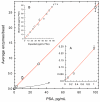Fifth-generation digital immunoassay for prostate-specific antigen by single molecule array technology
- PMID: 21998342
- PMCID: PMC3402036
- DOI: 10.1373/clinchem.2011.169540
Fifth-generation digital immunoassay for prostate-specific antigen by single molecule array technology
Abstract
Background: Measurement of prostate-specific antigen (PSA) in prostate cancer patients following radical prostatectomy (RP) has been hindered by the limit of quantification of available assays. Because radical prostatectomy removes the tissue responsible for PSA production, postsurgical PSA is typically undetectable with current assay methods. Evidence suggests, however, that more sensitive determination of PSA status following RP could improve assessment of patient prognosis and response to treatment and better target secondary therapy for those who may benefit most. We developed an investigational digital immunoassay with a limit of quantification 2 logs lower than current ultrasensitive third-generation PSA assays.
Methods: We developed reagents for a bead-based ELISA for use with high-density arrays of femtoliter-volume wells. Anti-PSA capture beads with immunocomplexes and associated enzyme labels were singulated within the wells of the arrays and interrogated for the presence of enzymatic product. We characterized analytical performance, compared its accuracy with a commercially available test, and analyzed longitudinal serum samples from a pilot study of 33 RP patients.
Results: The assay exhibited a functional sensitivity (20% interassay CV) <0.05 pg/mL, total imprecision <10% from 1 to 50 pg/mL, and excellent agreement with the comparator method. All RP samples were well within the assay measurement capability. PSA concentrations following surgery were found to be predictive of prostate cancer recurrence risk over 5 years.
Conclusions: The robust 2-log improvement in limit of quantification relative to current ultrasensitive assays and the validated analytical performance of the assay allow for accurate assessment of PSA status after RP.
Figures






Similar articles
-
Clinical evaluation of a novel method for the measurement of prostate-specific antigen, AccuPSA(TM) , as a predictor of 5-year biochemical recurrence-free survival after radical prostatectomy: results of a pilot study.BJU Int. 2012 Jun;109(12):1770-5. doi: 10.1111/j.1464-410X.2011.10568.x. Epub 2011 Oct 12. BJU Int. 2012. PMID: 21992499
-
Utility of a Fifth-Generation Ultrasensitive Prostate-Specific Antigen Assay for Monitoring Prostate Cancer Patients after Radical Prostatectomy with 3 Years of Follow-Up.Clin Chem. 2020 Oct 1;66(10):1329-1338. doi: 10.1093/clinchem/hvaa176. Clin Chem. 2020. PMID: 33001184
-
Nucleic acid detection immunoassay for prostate-specific antigen based on immuno-PCR methodology.Clin Chem. 2012 Apr;58(4):732-40. doi: 10.1373/clinchem.2011.170290. Epub 2012 Feb 23. Clin Chem. 2012. PMID: 22361936
-
Early detection of residual prostate cancer after radical prostatectomy by an ultrasensitive assay for prostate specific antigen.J Urol. 1993 Apr;149(4):787-92. doi: 10.1016/s0022-5347(17)36208-0. J Urol. 1993. PMID: 7681119
-
A brief review of ultrasensitive prostate-specific antigen assays for the evaluation of patients after radical prostatectomy.World J Urol. 1993;11(4):192-5. doi: 10.1007/BF00185067. World J Urol. 1993. PMID: 7508782 Review.
Cited by
-
Ultra-sensitive protein detection via Single Molecule Arrays towards early stage cancer monitoring.Sci Rep. 2015 Jun 8;5:11034. doi: 10.1038/srep11034. Sci Rep. 2015. PMID: 26052106 Free PMC article.
-
Enzyme molecules in solitary confinement.Molecules. 2014 Sep 12;19(9):14417-45. doi: 10.3390/molecules190914417. Molecules. 2014. PMID: 25221867 Free PMC article. Review.
-
Serum complexed and free prostate-specific antigen (PSA) for the diagnosis of the polycystic ovarian syndrome (PCOS).Clin Chem Lab Med. 2017 Oct 26;55(11):1789-1797. doi: 10.1515/cclm-2016-1124. Clin Chem Lab Med. 2017. PMID: 28361781 Free PMC article.
-
Helpful tool or blunt instrument?-the European Association of Urology Biochemical Recurrence Risk Classification as a decision-making tool for salvage radiotherapy.Transl Androl Urol. 2024 May 31;13(5):889-892. doi: 10.21037/tau-23-665. Epub 2024 May 17. Transl Androl Urol. 2024. PMID: 38855605 Free PMC article. No abstract available.
-
Serum complexed and free prostate specific antigen levels are lower in female elite athletes in comparison to control women.F1000Res. 2017 Jul 17;6:1131. doi: 10.12688/f1000research.11821.1. eCollection 2017. F1000Res. 2017. PMID: 28815018 Free PMC article.
References
-
- Oesterling JE. Prostate-specific antigen: A critical assessment of the most useful tumor marker for adenocarcinoma of the prostate. J Urol. 1991;145:907. - PubMed
-
- Diamandis EP. Prostate specific antigen—its usefulness in clinical medicine. Trends Endocrinol Metab. 1998;9:310–316. - PubMed
-
- Gunnar A. Second-Line Therapy after Radical Prostatectomy Failure: For Whom? When? How? Eur Urol. 2007;51:1155–58. - PubMed
-
- Bock JL, Klee GG. How sensitive is a prostate-specific antigen measurement? How sensitive does it need to be? Arch Pathol Lab Med. 2004;128:341–343. - PubMed
Publication types
MeSH terms
Substances
Grants and funding
LinkOut - more resources
Full Text Sources
Other Literature Sources
Medical
Research Materials
Miscellaneous

